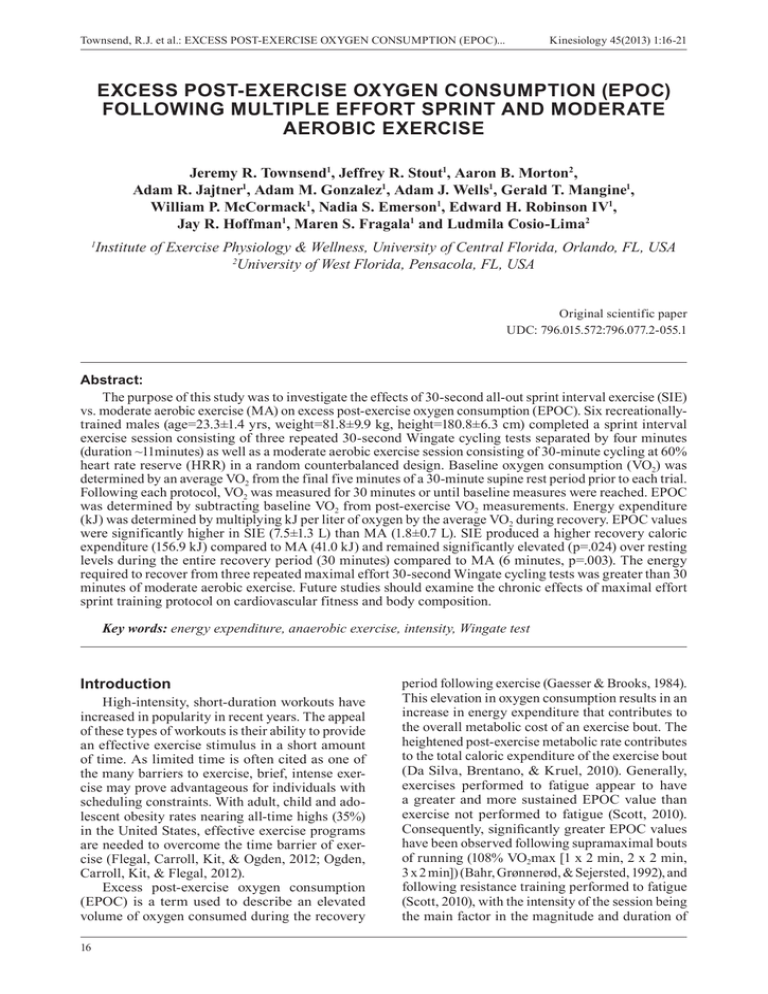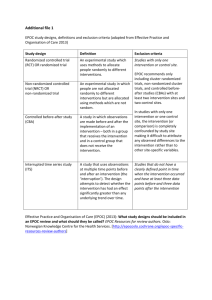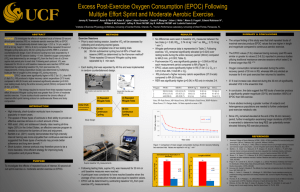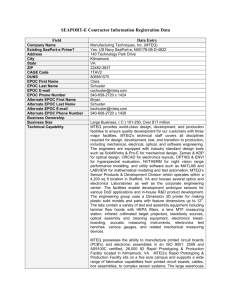Excess Post-Exercise Oxygen Consumption (EPOC) Following
advertisement

Townsend, R.J. et al.: EXCESS POST-EXERCISE OXYGEN CONSUMPTION (EPOC)... Kinesiology 45(2013) 1:16-21 EXCESS POST-EXERCISE OXYGEN CONSUMPTION (EPOC) FOLLOWING MULTIPLE EFFORT SPRINT AND MODERATE AEROBIC EXERCISE Jeremy R. Townsend1, Jeffrey R. Stout1, Aaron B. Morton2, Adam R. Jajtner1, Adam M. Gonzalez1, Adam J. Wells1, Gerald T. Mangine1, William P. McCormack1, Nadia S. Emerson1, Edward H. Robinson IV1, Jay R. Hoffman1, Maren S. Fragala1 and Ludmila Cosio-Lima2 Institute of Exercise Physiology & Wellness, University of Central Florida, Orlando, FL, USA 2 University of West Florida, Pensacola, FL, USA 1 Original scientific paper UDC: 796.015.572:796.077.2-055.1 Abstract: The purpose of this study was to investigate the effects of 30-second all-out sprint interval exercise (SIE) vs. moderate aerobic exercise (MA) on excess post-exercise oxygen consumption (EPOC). Six recreationallytrained males (age=23.3±1.4 yrs, weight=81.8±9.9 kg, height=180.8±6.3 cm) completed a sprint interval exercise session consisting of three repeated 30-second Wingate cycling tests separated by four minutes (duration ~11minutes) as well as a moderate aerobic exercise session consisting of 30-minute cycling at 60% heart rate reserve (HRR) in a random counterbalanced design. Baseline oxygen consumption (VO2) was determined by an average VO2 from the final five minutes of a 30-minute supine rest period prior to each trial. Following each protocol, VO2 was measured for 30 minutes or until baseline measures were reached. EPOC was determined by subtracting baseline VO2 from post-exercise VO2 measurements. Energy expenditure (kJ) was determined by multiplying kJ per liter of oxygen by the average VO2 during recovery. EPOC values were significantly higher in SIE (7.5±1.3 L) than MA (1.8±0.7 L). SIE produced a higher recovery caloric expenditure (156.9 kJ) compared to MA (41.0 kJ) and remained significantly elevated (p=.024) over resting levels during the entire recovery period (30 minutes) compared to MA (6 minutes, p=.003). The energy required to recover from three repeated maximal effort 30-second Wingate cycling tests was greater than 30 minutes of moderate aerobic exercise. Future studies should examine the chronic effects of maximal effort sprint training protocol on cardiovascular fitness and body composition. Key words: energy expenditure, anaerobic exercise, intensity, Wingate test Introduction High-intensity, short-duration workouts have increased in popularity in recent years. The appeal of these types of workouts is their ability to provide an effective exercise stimulus in a short amount of time. As limited time is often cited as one of the many barriers to exercise, brief, intense exercise may prove advantageous for individuals with scheduling constraints. With adult, child and adolescent obesity rates nearing all-time highs (35%) in the United States, effective exercise programs are needed to overcome the time barrier of exercise (Flegal, Carroll, Kit, & Ogden, 2012; Ogden, Carroll, Kit, & Flegal, 2012). Excess post-exercise oxygen consumption (EPOC) is a term used to describe an elevated volume of oxygen consumed during the recovery 16 period following exercise (Gaesser & Brooks, 1984). This elevation in oxygen consumption results in an increase in energy expenditure that contributes to the overall metabolic cost of an exercise bout. The heightened post-exercise metabolic rate contributes to the total caloric expenditure of the exercise bout (Da Silva, Brentano, & Kruel, 2010). Generally, exercises performed to fatigue appear to have a greater and more sustained EPOC value than exercise not performed to fatigue (Scott, 2010). Consequently, significantly greater EPOC values have been observed following supramaximal bouts of running (108% VO2max [1 x 2 min, 2 x 2 min, 3 x 2 min]) (Bahr, Grønnerød, & Sejersted, 1992), and following resistance training performed to fatigue (Scott, 2010), with the intensity of the session being the main factor in the magnitude and duration of Townsend, R.J. et al.: EXCESS POST-EXERCISE OXYGEN CONSUMPTION (EPOC)... EPOC (Abboud, Greer, Campbell, & Panton, 2012). Few investigations have examined short duration, intense exercise bouts in relation to EPOC. A recent study by Hazell, Olver, Hamilton, and Lemon (2012) found 24-hour energy expenditure was no different between four repeated 30-second maximal sprints with four minutes of active recovery between each sprint (18 minutes total) and a continuous 30-minute bout of aerobic exercise. While a considerably larger amount of energy was expended in the aerobic protocol, there was no statistical difference in energy expenditure over a 24-hour period. Therefore, the purpose of this study was to examine the effect of repeated exhaustive bouts of anaerobic exercise on EPOC values immediately following exercise compared to a continuous aerobic bout. Methods Participants Six recreationally-trained males (Mean±SD: age=23.3±1.4 yrs, body mass=81.8±9.9 kg, height =180.8±6.3 cm) were recruited for participation in this study. All participants completed a health questionnaire, Physical Activity Readiness Questionnaire (PAR-Q) and were determined fit to participate by the guidelines outlined by the American College of Sports Medicine (2009). All participants were informed of the nature of this study prior to participation as confirmed by a written informed consent in accordance with guidelines established by the Institutional Review Board. Procedures Each participant reported to the laboratory on three separate occasions: familiarization (FAM), Test 1; moderate aerobic (MA), and test 2; sprint interval exercise (SIE). During FAM, each participant met with investigators, where participants (a) were informed of the nature, scope, and risk of the procedures and gave their written informed consent; (b) completed a brief medical history; (c) had basic anthropometric measurements obtained; (d) and were familiarized with the use of all test instruments. The preliminary visit was completed 24–48 hours prior to the first testing date. Exercise sessions All participants underwent two testing trials completed within a two-hour time frame to minimize the effect of circadian rhythm. Each participant was informed of the date and time of their tests and was instructed to abstain from caffeine, alcohol and physical activity 24 hours prior to testing, and adherence to instructions was confirmed prior to each testing trial. A standardized meal replacement bar (43 g carbodydrate, 10 g protein, 6 g protein, 1004.6 kJ total) was consumed three hours prior to each testing trial, and water was consumed Kinesiology 45(2013) 1:16-21 ad libitum. Prior to each testing session, baseline VO2 was assessed by collecting and analyzing expired gases. Oxygen consumption was measured breath-by-breath using a standard metabolic cart (TrueMax 2400, Parvo Medics, Sandy, UT). Gas analyzers were calibrated with gases of known concentration before each test, and flow was calibrated prior to each test per operating instructions with a 3-L syringe. Baseline oxygen consumption (VO2) was determined by an average VO2 from the final five minutes of a 30-minute supine rest period prior to each trial with sampling time points spaced every minute. Participants then completed one of two testing trials: (a) a moderate aerobic exercise protocol consisting of a 30-minute submaximal cycling bout at 60% of heart rate reserve (HRR) as determined by the Karvonen method (Karvonen, Kental, & Mustala, 1957), and (b) three repeated 30-second Wingate cycling tests separated by four minutes each (SIE). Each testing trial was separated by 48 hours and was implemented in random counterbalanced design. An electronically braked cycle ergometer (Lode Excalibur, Groningen, Netherlands) was used during MA and a Monark 894E cycle ergometer (Varberg, Sweden) was used for all SIE trials. Heart rate (HR) was monitored continuously during resting, test and recovery periods using the Polar RS300x monitor (Kemplee, Finland). Recorded data in SIE consisted of peak power output, mean power, and fatigue index. Peak power was defined at the highest power output achieved during the test. Mean power was determined by the average power output over the 30-second test. Fatigue index was defined as dividing the highest power output by the lowest power output. Following testing trials, supine VO2 was measured for 30 minutes or until baseline measures were reached. A participant was considered to have reached baseline when the average of two consecutive minutes was equal to baseline values. EPOC was determined by subtracting baseline VO2 from post-exercise recovery VO2 measurements. All testing, including pre- and post-exercise VO2, was conducted in a controlled climate chamber (20–22ºC, 55% relative humidity). Energy expenditure (kJ) was determined by multiplying kcals per liter of oxygen (20.93 kJ∙L O2) by the average VO2 during recovery (Wilmore, et al., 1978). Statistical analysis All data were analyzed using SPSS, v. 20. An analysis of variance (ANOVA) with repeated measures was used to analyze post-exercise data with reference to baseline measures. Dependent t-tests were used to compare energy expenditure and EPOC values between trials. Data are represented as mean±SD. Significance is reported at the p<.05 level unless stated otherwise with an estimated 100% power at the 5% significance level. 17 Townsend, R.J. et al.: EXCESS POST-EXERCISE OXYGEN CONSUMPTION (EPOC)... Results Kinesiology 45(2013) 1:16-21 different between sprints 1 and 2 (p=.04) with 2 having the highest fatigue index of any sprint. Following exercise, VO2 remained significantly elevated (p=.024) over resting levels during the entire recovery period (30 minutes) compared to MA (6 minutes, p=.003; Table 2). Post-exercise VO2 was significantly greater (p=.004) in SIE at each measurement period compared to MA (Figure 1). EPOC values were significantly higher in SIE No differences were seen in baseline VO2 measures between the two trials (p=.90, SIEpre: 3.74 ml∙kg-1∙min-1 vs. MApre: 3.72 ml∙kg-1∙min-1). Wingate performance data is represented in Table 1. There was a significant time effect for peak power, mean power, relative mean power with the first Wingate test resulting in the largest power output for all. Fatigue index was only significantly Table 1. Wingate performance results. Note: PP=Peak Power, MP=Mean Power, RPP=Relative Peak Power, RMP=Relative Mean Power, FI=Fatigue Index. All data reported as mean (SD) Sprint PP(W) MP(W) RPP(W·kg-1) RMP(W·kg) FI(%) 1 983.9(134.0) 674.1(114.5) 2 876.1(131.5) 553.5(75.2) 11.9(2.0) 8.2(1.6) 53.9(6.2) 10.6(1.3) 6.6(0.4) 3 642(208.0) 428.5(98.7) 8.3(1.4) 61.4(7.6) 5.6(0.6) 54.6(13.5) Table 2. Comparisons in oxygen consumption following two exercise trials. Note: Values are reported as mean (SD) for gross oxygen consumption (VO2; ml∙kg-1 ∙min-1) and excess post-exercise oxygen consumption (EPOC; ml∙kg-1 ∙min-1).*Significant difference (p<.05) between the two exercise trials. ǂ Elevated significantly (p<.05) above resting values MA Time (min) 1 2 3 4 5 6 7 8 9 10-15 15-20 20-25 25-30 Average: SIE VO2 EPOC VO2 EPOC 13.17 (2.02)ǂ 6.98 (1.20)ǂ 5.30 (0.86)ǂ 4.82 (0.44)ǂ 4.80 (0.44)ǂ 4.12 (0.39)ǂ 4.35 (0.29) 4.20 (0.83) 9.43 (2.22)ǂ 3.25 (1.35)ǂ 1.56 (1.07)ǂ 1.08 (0.68)ǂ 1.06 (0.50)ǂ 0.38 (0.44)ǂ 0.60 (0.40) 0.44 (0.52) 21.13 (1.61)*ǂ 12.33 (1.58)*ǂ 10.18 (1.67)*ǂ 8.72 (0.91)*ǂ 7.95 (1.25)*ǂ 7.17 (1.17)*ǂ 7.12 (1.07)*ǂ 6.77 (1.34)*ǂ 17.41 (1.55)*ǂ 8.62 (1.77)*ǂ 6.47 (1.78)*ǂ 5.00 (1.15)*ǂ 4.23 (1.42)*ǂ 3.43 (1.06)*ǂ 3.40 (0.89)*ǂ 3.05 (1.27)*ǂ 4.06 (0.42) 3.99 (0.44) 3.74 (0.21) 3.79 (0.25) 3.68 (0.29) 4.41 (1.81) 0.32 (0.39) 0.31 (0.44) 0.17 (0.26) 0.20 (0.29) 0.18 (0.32) 0.77 (1.78) 6.70 (1.42)*ǂ 6.19 (0.97)*ǂ 5.70 (0.84)*ǂ 5.24 (0.74)*ǂ 4.99 (0.47)*ǂ 6.85 (3.21) 2.98 (1.47)*ǂ 2.47 (0.95)*ǂ 1.99 (1.08)*ǂ 1.52 (1.04)*ǂ 1.27 (0.97)*ǂ 3.12(3.19) 25 VO2 (ml∙kg -1∙min-1) 20 SIE MA 15 10 5 Ba 5 0 -3 -2 20 25 20 14 12 13 9 10 11 8 7 5 4 3 2 1 6 Time Post-Exercise (min) 15 - se lin e 0 Figure 1. Comparison of mean oxygen consumption during a 30-minute recovery following two exercise trials. Values are reported in ml∙kg-1∙min-1. 18 Townsend, R.J. et al.: EXCESS POST-EXERCISE OXYGEN CONSUMPTION (EPOC)... (7.5±1.3 L∙O2, p=.012) than MA (1.8±.65 L∙O2). SIE produced a higher recovery caloric expenditure (156.9 kJ) compared to MA (41.0 kJ). Energy expenditure was significantly higher (p=.04) in SIE only in minutes 2–4. The average HR during recovery was significantly higher (p=.00) in SIE (116.4±3.3 bpm) compared to MA (79.8±2.4 bpm). Discussion and conclusions The main finding of this study was that brief repeated bouts of maximal exercise produced EPOC values that are higher in duration and magnitude compared to continuous aerobic exercise. The EPOC values (7.5 L) observed during recovery post SIE were greater than values (5.96 L) reported in a previous study utilizing a protocol that included four repeated sprint bouts (Hazell, et al., 2012)). While the SIE exercise session was substantially shorter than the MA (~11minutes vs. 30 minutes), the metabolic cost measured during the recovery period was significantly greater (p<.001) at each time point in recovery. It is also important to note that while the total SIE session lasted 11 minutes, the amount of actual exercise only lasted 1.5 minute. Oxygen consumption remained elevated during the entire 30-minute recovery period in SIE, and remained elevated when the measurement period ended. This is similar to the findings of Chan and Burns (2013) who found VO2 significantly elevated for 30 minutes post-exercise. Although VO2 was not measured following 30 minutes post-exercise, considering that VO2 were higher in the present study, it is likely that oxygen consumption would have remained elevated past the 30-minute mark. The greatest elevation of VO2 above baseline was observed in the anaerobic trial and lasted throughout the 30-minute recovery period. VO2 remained elevated during recovery for the first six minutes of the MA trial resulting in a 28.9 kJ increase during this period and 41.0 kJ increase overall. In contrast, a 156.9 kJ increase was observed during the 30-minute anaerobic trial. The calorie expenditure noted in the SIE (156.9 kJ) trial was larger than values (124.9 kJ) previously reported by Hazell and colleagues (2012) during their 18-minute SIE protocol. Interestingly, our findings demonstrate higher O2 consumption levels with only three sprints compared to the four utilized in the protocol by Hazell and colleagues (2012). While sprint performance data was not reported in that study, it is possible that the higher VO2 values found in this study were due to a potentially larger amount of work completed. The SIE bout of exercise resulted in post-exercise VO2 and EPOC measures 34% higher than moderate steady-state ergometry. The results of this study support the hypothesis that the magnitude of EPOC and its duration is primarily dependent on exercise intensity (Bahr, et al., 1992; Laforgia, Withers, & Gore, 2006; Thornton & Kinesiology 45(2013) 1:16-21 Potteiger, 2002). The traditional “Oxygen Debt” theory may also explain how greater exercise intensity may further increase the oxygen deficit at the onset of exercise, thus affecting the body’s homeostatic nature, and resulting in a larger postexercise O2 intake (Sedlock, 1992; Thornton & Potteiger, 2002). While not measured in this study, mechanisms responsible for this extended increase in VO2 have been proposed and documented such as the energy cost of resynthesis of glycogen from lactate, exercise-induced increase in core temperature, resynthesis of ATP/CP stores and changes in cytokine release (Bahr, et al., 1992; Laforgia, et. al., 2006; Scott, 2010; Borsheim & Bahr, 2003). A number of investigations (Bahr, et al., 1992; Laforgia, Withers, & Gore, 1997) have examined the effects of supramaximal exercise on EPOC where exercise intensity was prescribed as a percentage of VO2max. Bahr et al. (1992) found a 5.6 L increase in oxygen consumption levels above baseline during and following a single two-minute cycling bout at 108% VO2max. The highest EPOC value reported in that study was 7.8 L (3 x 2 minutes at 108% VO2max) over a four-hour period post-exercise. The findings of our study show similar EPOC values (7.5L) to the 3 x 2 minute protocol (7.8 L). Although EPOC measurement time was shorter in the present study (30 minutes vs. 1 hour), it is likely that if EPOC measures were prolonged in the present study to match that of Bahr et al. (1992), oxygen consumption following SIE may have surpassed that seen in previous supramaximal protocols. Previous research has suggested that MA may produce a larger caloric expenditure during the actual exercise bout compared to SIE (Hazell, et al., 2012; Laforgia, et al., 1997); however, data from EPOC suggests that SIE exercise protocols may result in a greater caloric expenditure than steady state exercise protocols. Post-exercise caloric expenditure could account for substantial caloric deficits (~1088.4 kJ per week) resulting in significant weight loss over time; assuming total kJ intake did not change. Chronic repeated maximal exercise may therefore have the potential to aid in weight management. Recently, MacPherson, Hazell, Olver, Patterson, and Lemon (2011) demonstrated that six weeks of high intensity sprint training resulted in an equal reduction of fat mass compared to moderate aerobic training over the same six-week period with a fraction of the time commitment. There are several limitations to this investigation. While small sample sizes have been utilized in similar studies (Bahr et al., 1992; Sedlock, et al., 1992; Laforgia, et al., 1997), a larger sample size or repeated trials would have strengthened our findings. It would also be appropriate to include a control group in future studies as well as extending the EPOC measurement period to determine the complete effects of this three-sprint protocol. While 19 Townsend, R.J. et al.: EXCESS POST-EXERCISE OXYGEN CONSUMPTION (EPOC)... participants were instructed to give a maximal effort, it is a possible that they did not give an “allout” effort on every sprint trial. This can possibly be inferred from fatigue index that was highest after the second bout which does not coincide with previous studies. This may be due to participants’ inexperience with maximal exercise. However, average mean power outputs (674, 554, 429 W) do suggest an adequate effort by all participants. Kinesiology 45(2013) 1:16-21 The results of this study suggest that SIE produced a significantly greater duration and magnitude of EPOC than MA exercise. Although speculative, the greater caloric expenditure seen during the acute SIE protocol may provide a greater stimulus for weight loss if continued for a prolonged duration, and serve as an alternative to more time consuming training programs. Furthermore, future studies involving a greater number of subjects and heterogeneous populations are needed to better understand and quantify post-exercise metabolic rate. References Abboud, G.J., Greer, B.K., Campbell, S.C., & Panton, L.B. (2012). Effects of load-volume on EPOC after acute bouts of resistance training in resistance trained males. Journal of Strength & Conditioning Research, Published ahead of print. American College of Sports Medicine. (2009). American College of Sports Medicine position stand. Progression models in resistance training for healthy adults. Medicine and Science in Sports and Exercise, 41(3), 687–708. Bahr, R.D., Grønnerød, O., & Sejersted, O.M. (1992). Effect of supramaximal exercise on excess postexercise O2 consumption. Medicine and Science in Sports and Exercise, 24(1), 66. Borsheim, E., & Bahr, R. (2003). Effect of exercise intensity, duration and mode on post-exercise oxygen consumption. Sports Medicine, 33(14), 1037–1060. Chan, H.H., & Burns, S.F. (2013). Oxygen consumption, substrate oxidation, and blood pressure following sprint interval exercise. Applied Physiology, Nutrition, and Metabolism, 38(999), 182–187. Da Silva, R.L., Brentano, M.A., & Kruel, L.M. (2010). Effects of different strength training methods on post exercise energetic expenditure. Journal of Strength and Conditioning Research, 24(8), 2255–2260. Flegal, K.M., Carroll, M.D., Kit, B.K., & Ogden, C.L. (2012). Prevalence of obesity and trends in the distribution of body mass index among US adults, 1999-2010. JAMA, 307(5), 491–497. Gaesser, G.A., & Brooks, G.A. (1984). Metabolic bases of excess post-exercise oxygen consumption: A review. Medicine and Science in Sports and Exercise, 16(1), 29. Hazell, T.J., Olver, D., Hamilton, C.D., & Lemon, P.R. (2012). Two minutes of sprint-interval exercise elicits 24-hr oxygen consumption similar to that of 30-min of continuous endurance exercise. International Journal of Sport Nutrition and Exercise Metabolism, 22(1), 276–283. Karvonen, M.J., Kentala, E., & Mustala, O. (1957). The effects of training on heart rate: A longitudinal study. Annales Medicinae Experimentalis et Biologiae Fenniae, 35(3), 307–315. LaForgia, J., Withers, R.T., & Gore, C.J. (1997). Comparison of energy expenditure elevations after submaximal and supramaximal running. Journal of Applied Physiology, 82(1), 661–666. LaForgia, J., Withers, R.T., & Gore, C.J. (2006). Effects of exercise intensity and duration on the excess post-exercise oxygen consumption. Journal of Sport Science, 24(12), 1247–1264. Macpherson, R.E., Hazell, T.J., Olver, T.D., Paterson, D.H., & Lemon, P.W. (2011). Run sprint interval training improves aerobic performance but not maximal cardiac output. Medicine and Science in Sports and Exercise, 43(1), 115–122. Ogden, C.L., Carroll, M.D., Kit, B.K., & Flegal, K.M. (2012). Prevalence of obesity and trends in body mass index among US children and adolescents, 1999-2010. JAMA, 307(5), 483–490. Scott, C.B. (2010). Quantifying the immediate recovery energy expenditure of resistance training. Journal of Strength and Conditioning Research, 25(4), 1159–1163. Sedlock, D.A. (1992). Post-exercise energy expenditure after cycle ergometer and treadmill exercise. Journal of Applied Sport Science Research, 6(1), 19–23. Thornton, K.M., & Potteiger, J.A. (2002). Effects of resistance exercise bouts of different intensities but equal work on EPOC. Medicine and Science in Sports and Exercise, 34(4), 715–722. Wilmore, J.H., Parr, R.B., Ward, P.L., Vodak, P.A., Barstow, T.J., Pipes, T.V., & Leslie, P. (1978). Energy cost of circuit weight training. Medicine and Science in Sports and Exercise, 10(2), 75–78. 20 Townsend, R.J. et al.: EXCESS POST-EXERCISE OXYGEN CONSUMPTION (EPOC)... Kinesiology 45(2013) 1:16-21 POVEĆANA POTROŠNJA KISIKA NAKON VJEŽBANJA (EPOC) ZABILJEŽENA NAKON VIŠEKRATNIH SPRINTOVA I UMJERENE AEROBNE AKTIVNOSTI Cilj je ovog istraživanja bio utvrditi učinke maksimalnog intervalnog sprintanja po 30 sekunda (SIE) i usporediti ih s umjerenim aerobnim treniranjem (MA) na povišenu potrošnju kisika nakon vježbanja. Šest muškaraca rekreativaca (23.3±1.4 godina, 81.8 ± 9.9 kg i 180.8 ± 6.3 cm) je, u slučajnom uravnoteženom nacrtu eksperimenta, provelo intervalni sprinterski trening koji se sastojao od tri ponavljanja Wingate testa (30 sekunda) na biciklu s odmorima po 4 minute (ukupno trajanje zadatka približno 11 minuta) te umjereni aerobni trening koji se sastojao od 30 minuta bicikliranja intenzitetom od 60% rezerve srčane frekvencije. Početni primitak kisika (VO2) je bio utvrđen kao prosječna vrijednost VO2 zabilježena u zadnjih 5 minuta 30-minutnog odmora u ležećem položaju koji se primjenjivao prije svakog eksperimentalnog protokola. Nakon svakog protokola, VO2 je bio mjeren tijekom 30 minuta ili do trenutka kada se VO2 spustio na početnu vrijednost. EPOC je utvrđen oduzimanjem početne vrijednosti VO2 od vrijednosti VO2 zabilježenih nakon eksperi- mentalnih protokola. Energetska potrošnja (kJ) je bila utvrđena množenjem potrošenih kJ po litri kisika s prosječnim VO2 tijekom oporavka. Vrijednosti EPOC-a bile su značajno više u sprinterskoj grupi (SIE 7,5±1,3 l) u odnosu na vrijednosti u grupi MA (1,8±0,7). Sprinterski zadatak je proizveo višu kalorijsku potrošnju tijekom oporavka (156,9 kJ) u usporedbi s umjerenim aerobnim zadatkom MA (41,0 kJ) te je ona ostala značajno povišena (p=0,024) u odnosu na razinu u mirovanju tijekom cijelog perioda oporavka (30 minuta) za razliku od MA (6 minuta, p=0,003). Potrebna energija za oporavak nakon 3 ponovljena maksimalna Wingate testa od 30 sekunda bila je viša nego nakon 30 minuta umjerene aerobne aktivnosti. Buduća istraživanja trebala bi ispitati kronične učinke protokola maksimalnih sprinterskih napora na kardiovaskularni fitnes i sastav tijela. Ključne riječi: energetska potrošnja, anaerobno vježbanje, intenzitet, Wingate test Submitted: February 8, 2013 Accepted: June 4, 2013 Correspondence to: Jay R. Hoffman, Ph.D., FNSCA, FACSM Sport and Exercise Science University of Central Florida 4000 Central Florida Blvd, Orlando, Florida, USA Phone: 407-823-1272 Email: jay.hoffman@ucf.edu 21


